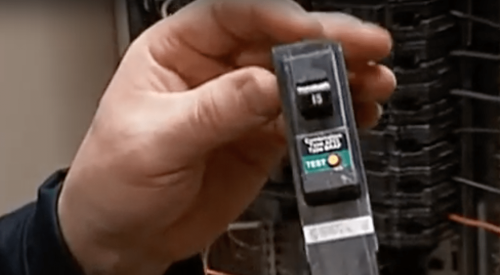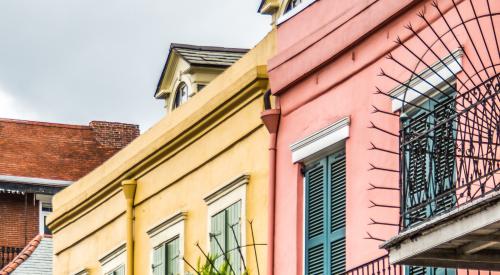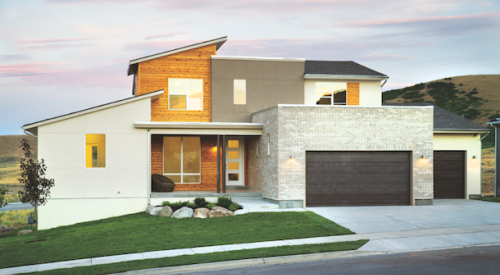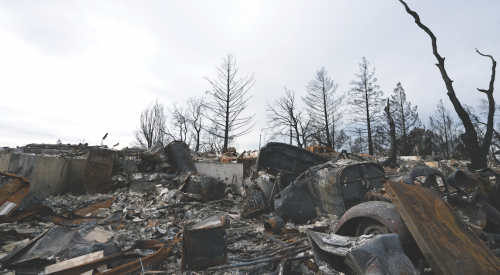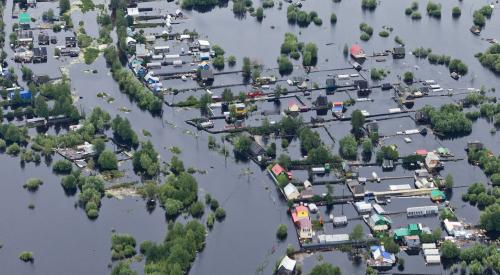|
The sprinkler in this picture (the small circle on the ceiling above the stove) is practically invisible compared to the speakers and lights.
|
Fires kill more people in the United States each year than all natural disasters combined, according to the National Fire Protection Association. Approximately 80 percent of all fire-related deaths occur in the home; however, only 2 percent of new homes have sprinklers installed.
To raise awareness of sprinklers and educate both builders and home buyers as to its benefits, the U.S. Federal Emergency Management Agency (FEMA) presented the Home Fire Sprinkler Coalition with a Fire Prevention and Safety Grant of almost $600,000. HFSC is using the money for "Built for Life," the first national sprinkler-education effort directed toward U.S. builders and developers. HFSC was formed in 1996 by fire protection trade groups and equipment manufacturers to inform trades people and the public about the life-saving value of home fire sprinklers, particularly in the construction of new one- and two-family dwellings.
Combined with smoke alarms, residential fire sprinklers cut the risk of dying in a house fire by 82 percent, according to NFPA. Despite the fact that fire sprinklers are the most effective way to prevent fire-related deaths, builders and home buyers still are hesitant about having them installed in their new homes.
"People are really nervous about sprinklers in general due to their appearance and cost," says Al Patenaude of Al Patenaude Construction in Pepperell, Mass. Patenaude decided he should learn more about sprinklers after his customers began asking about them. He found out that residential sprinklers are small, easily concealed and cost about $2 per square foot.
Each sprinkler can cover, at a minimum, a 12x12-foot area. Typically, only one sprinkler is necessary to protect a standard 20x20-foot bedroom. "Considering what consumers spend on cabinets and flooring, I think it's pretty reasonably priced," says Patenaude, who now offers sprinklers as an option in the homes his company builds.
More than 200 jurisdictions nationwide require sprinklers in some or all new one- and two-family homes, as well as in multi-family dwellings. Among the first was in Arizona in 1982, when the Scottsdale Rural/Metro Fire Department put residential sprinklers to the test by setting a series of 10 fires in multiple homes and observing the aftermath. Houses with sprinklers were able to put out fires just minutes after they began.
"In 1985, the Scottsdale city council passed an ordinance that basically said, if you build homes here, you must install sprinklers," says Jim Ford, assistant chief and fire marshal of the Scottsdale Rural/Metro Fire Department. In the first 15 years after the ordinance was passed, at least 13 lives were saved and $760 million worth of property was spared thanks to sprinklers, Ford says.
Other cities are beginning to follow in Scottsdale's footsteps. Bill Schermerhorn, of Edward R. James Homes, says that his company was required by the city of Bartlett, Ill., to choose between four-hour walls or two-hour walls with sprinklers when building homes in this area.
"We chose the two-hour walls with sprinklers, and it has been a pretty well-received decision," says Schermerhorn. "The salespeople say it's a plus that sets us aside from other builders." In order for salespeople to promote residential sprinklers to home buyers, they must be educated about the benefits of sprinklers.
Sprinklers' Benefits
If homeowners choose to install sprinklers in their homes, they may receive lower home-insurance premiums and reduced property loss if there's a fire. In a sprinklered home, only the individual sprinkler closest to the flame activates, and 90 percent of fires are extinguished with just one sprinkler. So, the water is sprayed directly on the affected area and does not drench the entire house. According to HFSC, homes with sprinklers suffer financial losses 90 percent lower than homes without sprinklers.
Residential sprinklers are much more inconspicuous than they used to be, says Gary S. Keith, HFSC chairperson, and that bolsters their appeal to home buyers.
Sprinklers can be in-stalled in walls or recessed into ceilings. Although sprinklers tend to be about 2 inches long, less than 1/4 of an inch of the sprinkler is exposed beneath the ceiling, says Sandra Wake, marketing manager for The Viking Corp., a sprinkler manufacturer.
Sprinklers allow builders to situate houses closer together and closer to property lines because fire danger is lessened. With sprinklers, builders also can build on more narrow street widths and longer dead end streets, creating additional space for building. Builders also may achieve better trade-up margins, while enhancing their reputations for building a safe, high-quality product. "It gives people a better comfort level and puts me in a better market range," says Patenaude.
Built for Life
HFSC's "Built for Life" educational campaign will link builders and developers with sprinkler contractors and fire service members. Sprinkler systems will be installed in pilot sites in select model homes. HFSC will provide on-site training and educational materials for builders and potential home buyers.
According to both Keith and Patenaude, as more consumers begin asking questions about sprinklers, more builders will begin offering them as an option or even as standard in the homes they build. For more information call 888/635-7222 or visit www.homefiresprinkler.org.
- Nationwide, more than 4,000 people die in fires each year.
- The accidental discharging of a home fire sprinkler is less likely and less severe than accidents involving home plumbing systems.
- Eight out of 10 fire deaths occur in the home.
- Home fire sprinklers can contain and possibly extinguish a fire in less time than it would take firefighters to arrive on the scene.
- On average, home fire sprinklers use 341 gallons of water to contain a fire. Firefighters use around 2,935 gallons.
- According to a national survey conducted by the National Fire Protection Association, 92 percent of respondents thought sprinklers were an effective tool for protecting people from fires.
- Only half of these respondents knew that fire sprinklers could be installed in their homes.

